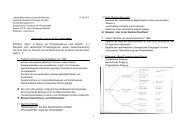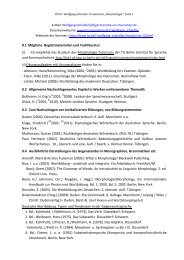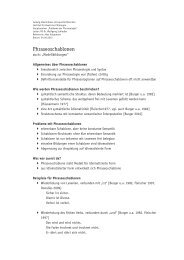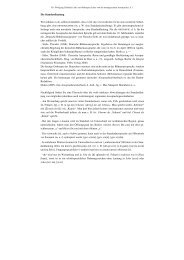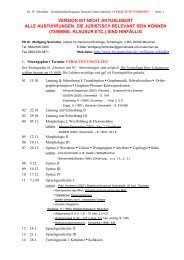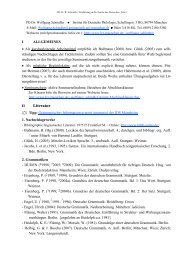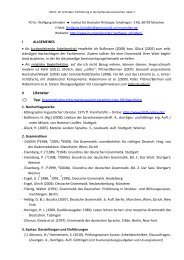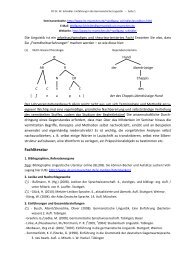Chapter 18 Lexical Functions: Description of Lexical Relations in a ...
Chapter 18 Lexical Functions: Description of Lexical Relations in a ...
Chapter 18 Lexical Functions: Description of Lexical Relations in a ...
You also want an ePaper? Increase the reach of your titles
YUMPU automatically turns print PDFs into web optimized ePapers that Google loves.
—<strong>Chapter</strong> <strong>18</strong>. <strong>Lexical</strong> <strong>Functions</strong>— 15<br />
A l<strong>in</strong>guistic expression that constitutes an element <strong>of</strong> the value {L´i} <strong>of</strong> an LF f when<br />
applied to L (f(L) = {L´ i }) can be, generally speak<strong>in</strong>g, <strong>of</strong> one <strong>of</strong> the five types, that is, L´ can be:<br />
— a lexical unit<br />
1) a lexeme : Magn(smoker) = heavy [smoker]<br />
2) a phraseme (<strong>in</strong>clud<strong>in</strong>g<br />
collocations) : Magn(smokeV) = [smoke] klike a chimneyl<br />
Magn(ra<strong>in</strong>V) = [ra<strong>in</strong>] kcats and dogsl 4<br />
— a morphological element<br />
3) a compound<strong>in</strong>g stem : Magn(smoker) = cha<strong>in</strong>-[smoker]<br />
4) a derivational affix : S 1(smokeV) = [smok]+er<br />
— a free phrase<br />
5) : Magn(smokeV) = [smoke] more than a battalion <strong>of</strong> firefighters,<br />
without stopp<strong>in</strong>g, light<strong>in</strong>g up a cigarette from<br />
the other, ...<br />
(Cf. Her marriage is as DEAD as the rema<strong>in</strong>s <strong>of</strong> some Wooly Mammoth unearthed by researchers<br />
<strong>in</strong> Siberia, or some such place; the underscored free phrase <strong>in</strong>tensifies the adjective DEAD.)<br />
Now the two relevant def<strong>in</strong>itions can be formulated: <strong>Lexical</strong> <strong>Functions</strong> and Standard<br />
<strong>Lexical</strong> <strong>Functions</strong>.<br />
2.2. Def<strong>in</strong>ition <strong>of</strong> <strong>Lexical</strong> Function<br />
As was already stated, a <strong>Lexical</strong> <strong>Functions</strong> f is a correspondence between lexical expres-<br />
sions (<strong>of</strong> language L) that is associated with a mean<strong>in</strong>g (f) and a (deep-)syntactic role. Accord<strong>in</strong>g<br />
to this characterization, f is applicable or not applicable to LUs <strong>of</strong> particular semantic/<br />
syntactic classes. The notion <strong>of</strong> applicability <strong>of</strong> an LF f to an LU L is based on semantic compati-<br />
bility <strong>of</strong> f and L—that is, on the compatibility <strong>of</strong> the mean<strong>in</strong>gs (f) and (L). Formally, the applicabi-<br />
lity must be explicitly specified for each f by <strong>in</strong>dication <strong>of</strong> the semantic class <strong>of</strong> the correspond-<br />
<strong>in</strong>g LUs—i.e., LUs that can be arguments <strong>of</strong> f. If f is applicable to L, we will say that f is<br />
def<strong>in</strong>ed for L.


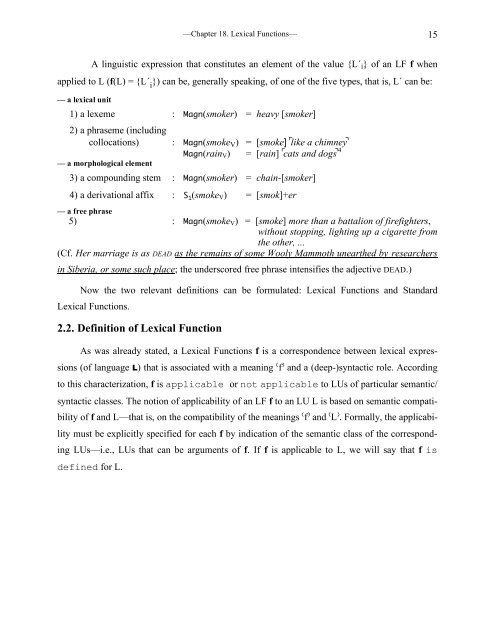
![E-Mail: Wolfgang.Schindler[ätt]germanistik.uni-muenchen.de Web ...](https://img.yumpu.com/51590147/1/184x260/e-mail-wolfgangschindlerattgermanistikuni-muenchende-web-.jpg?quality=85)
